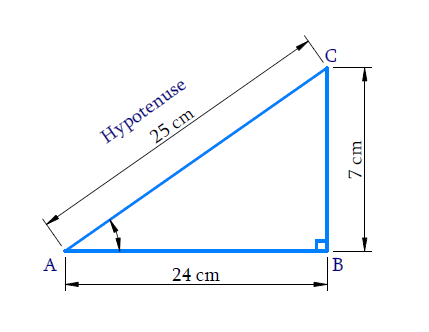In ∆ ABC, right-angled at B, AB = 24 cm, BC = 7 cm. Determine :
(i) sin A, cos A (ii) sin C, cos C
Solution:
We use the basic formulas of trigonometric ratios to solve the question.

Applying the Pythagoras theorem for ∆ABC, we can find the hypotenuse (side AC). Once hypotenuse is known, we can find sine and cosine angles using trigonometric ratios.
In ΔABC, we obtain,
AC2 = AB2 + BC2
= 242 + 72
= 576 + 49
= 625
∴ Hypotenuse AC = √625 cm = 25 cm
(i)

sin A = side opposite to ∠A / hypotenuse = BC/AC
sin A = 7 cm /25 cm = 7/25
sin A = 7/25
cos A = side adjacent to ∠A / hypotenuse = AB/AC
= 24 cm / 25 cm = 24/25
cos A = 24/25
(ii)

sin C = side opposite to ∠C / hypotenuse = AB/AC
sin C = 24 cm / 25 cm = 24/25
sin C = 24/25
cos C = side adjacent to ∠C / hypotenuse = BC/AC
= 7 cm / 25 cm = 7/25
cos C = 7/25
☛ Check: NCERT Solutions Class 10 Maths Chapter 8
Video Solution:
In ΔABC, right-angled at B, AB = 24 cm, BC = 7 cm. Determine: (i) sin A, cos A (ii) sin C, cos C
Maths NCERT Solutions Class 10 Chapter 8 Exercise 8.1 Question 1
Summary:
In ΔABC, right-angled at B, AB = 24 cm, BC = 7 cm, then sin A, cos A is 7/25 and 24/25 respectively and sin C, cos C is 24/25 and 7/25 respectively.
☛ Related Questions:
visual curriculum